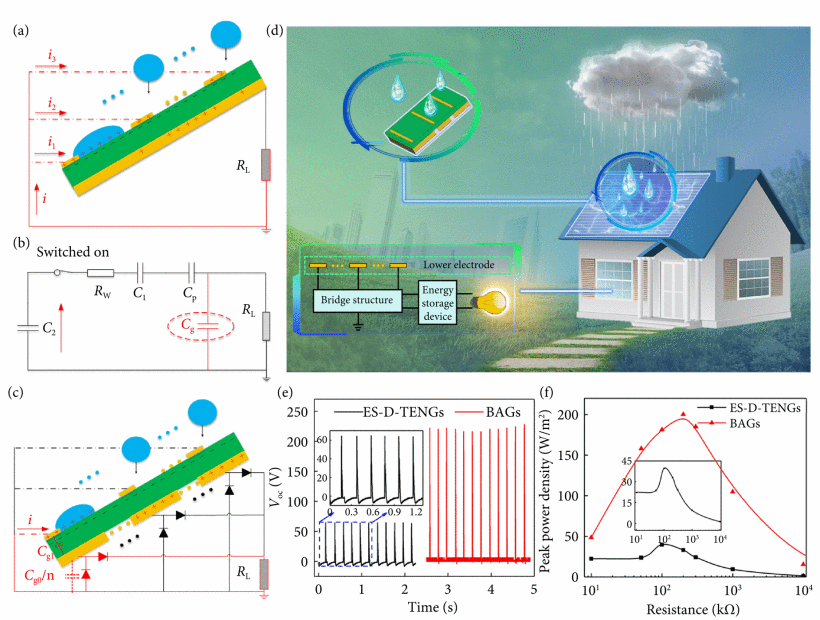
As the world seeks sustainable alternatives to fossil fuels, researchers at Tsinghua University in Shenzhen, China, have ingeniously turned their gaze to the heavens above for inspiration. Embracing the panel arrangement used in solar cells, they have unlocked the potential to harness electricity from falling raindrops. This groundbreaking development has not only breathed new life into renewable energy sources but also addressed the long-standing challenge of scaling up raindrop-based electricity generation.
Untapped Potential of Raindrop Kinetic Energy
Imagine capturing the power of falling raindrops and converting their kinetic energy into electricity. It may sound like a fanciful idea, but it’s rooted in solid science. Raindrops, as they descend from the sky, carry a latent energy that can theoretically be captured and utilized. Previous attempts at tapping into this resource involved liquid-solid contact electrification and the use of Triboelectric nanogenerators (TENG) to harness energy from various sources like waves. However, these methods struggled with scalability.
 Proposition of bags. (a) structure diagram of ES-D-tengs. (b) the equivalent circuit diagram of ES-D-tengs. Cp,C1,C2,Rw are the capacitor between the FEP film and the lower electrode, the electric double layer capacitor between water/fep interface, the electric double layer capacitor between water/upper electrode interface, the equivalent resistance of droplet, respectively. (c) structure diagram of bags. (d) application scenarios of bags. (e) the open-circuit voltage of bags and ES-D-tengs. (f) The peak power of bags and ES-D-tengs.Courtesy of Zong Li et al. 2023
Proposition of bags. (a) structure diagram of ES-D-tengs. (b) the equivalent circuit diagram of ES-D-tengs. Cp,C1,C2,Rw are the capacitor between the FEP film and the lower electrode, the electric double layer capacitor between water/fep interface, the electric double layer capacitor between water/upper electrode interface, the equivalent resistance of droplet, respectively. (c) structure diagram of bags. (d) application scenarios of bags. (e) the open-circuit voltage of bags and ES-D-tengs. (f) The peak power of bags and ES-D-tengs.Courtesy of Zong Li et al. 2023
In the realm of raindrop energy harvesting, droplet-based TENG, known as D-TENGs, offered high instantaneous output. However, a single D-TENG could not generate the megawatt-level electricity typically produced by power plants. The obvious solution seemed to lie in connecting multiple D-TENGs, but doing so led to an undesirable side effect. The connection caused unintended coupling capacitance between upper and lower electrodes, resulting in reduced device output.
Bridge Array Generators to the Rescue
Breaking through the barriers hindering raindrop energy scalability, a team of researchers, led by Professor Zong Li at Tsinghua Shenzhen International Graduate School, found inspiration in solar panels. By adopting the concept of bridge array generators, they mitigated the influence of unwanted capacitance and paved the way for a revolution in raindrop energy harvesting.
When raindrops make contact with the surface of a D-TENG panel, an intriguing phenomenon unfolds. The droplets acquire a positive charge, while the surface develops a negative charge. Each droplet’s charge may be modest, but with time, the accumulated charge on the panel surface reaches saturation. This equilibrium between charge generation and dissipation allows for continuous raindrop energy conversion.
The researchers employed bridge array generators featuring different sizes of sub-electrodes and panels with various thicknesses to explore the impact on power loss. What they discovered was truly astonishing. D-TENG panels incorporating bridge array generators operated independently, significantly reducing unintended power loss. The peak power output of these generators exceeded that of conventional large-area raindrop energy systems by nearly five times, reaching 200 watts per square meter.
With this groundbreaking discovery, a new era in renewable energy has dawned, especially in regions with frequent and copious rainfall. The potential to tap into raindrop energy on a large scale offers a ray of hope for sustainable power generation. The future is bright, as we harness the forces of nature to power a cleaner, greener tomorrow-one drop at a time.







